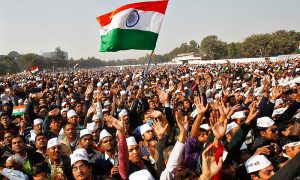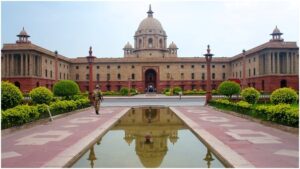Table of Contents
Introduction
The legal powers of the President are thus vast. Yet he is intended to stand in relation to the Union Administration substantially in the same position as does the King under the English Constitution. He is the Nominal or Constitutional Head of the government. His position is not like that of the President of the US who is the real executive head and exercises the powers vested in him under the Constitution on his own initiative and responsibility. In the context of the legislative-executive relations established by the provisions of the constitution, the Presidential form of government prevailing in the US is ruled out and it is a Parliamentary type of Government that is provided by the constitution of India.
In estimating the constitutional position of the President of India, the provisions of Articles 53, 74 and 75 may particularly be referred to.
- Article 53 vests the executive power of the Union in the President, but he is required to exercise his powers in accordance with the Constitution.
- Article 74 of the Constitution says that there shall be a Council of Ministers to aid and advise the President in the exercise of his functions and he has to act in accordance with such advice.
- Article 75(3) lays down that the Council of Ministers shall be collectively responsible to the House of the People. There is no provision in the Constitution which makes the President answerable to the legislature. It will be meaningless to say that the Ministers are answerable for the policy and administration of the Union to the House of the People, unless they are recognised to possess the authority to finally decide the affairs relating to the government.
Therefore, the real directing force is the Cabinet and not the President.
Leading Case Laws
The framers of the Constitution had no doubt as to the form of the government they were setting up. They had clearly proposed the parliamentary form of government under which the president is the constitutional or formal head of the union, so so also is the constitutional position of the Governor in the states. The supreme court had consistently taken the view that the powers of the president and the powers of the Governor are similar to the power of the Crown under the British Parliament.
Ram Jawaya Kapur vs State of Punjab
In the case of Ram Jawaya Kapur vs State of Punjab, Mukherjea CJ speaking for the court stated that, though the executive power is vested in the President, the President is only a formal or constitutional head of the executive. The real power is vested in the Council of Ministers on whose aid and advice the President acts in the exercise of his functions. The executive has the primary responsibility
for the formulation of governmental policy and its transmission into law. But it is responsible for all its actions to the legislature and, therefore, it must retain the confidence of the legislature. The basis of this responsibility is embodied in Article 75(3)
U.N.R. Rao v. Indira Gandhi
In another case of U.N.R. Rao v. Indira Gandhi, it was emphasised that our Constitution is modelled on the British parliamentary system. Under this system, the Council of Ministers enjoying a majority in the legislature concentrates in itself the virtual
control of both executive and legislative functions. Article 74(1) which provides for a Council of Ministers to aid and advise the President in the exercise of his functions is mandatory. The harmonious reading of the mandatory character of Article 74(1) along with Article 75(2) and Article 75 (3) is that the President cannot exercise executive powers without the aid and advice of the Council of Ministers even after the President has dissolved the legislature.
Shamsher Singh vs State of Punjab
In Shamsher Singh vs State of Punjab, the question was raised in the court, whether a member of the subordinate judiciary can be dismissed by the Governor personally or in accordance with the aid and advice of the Council of Ministers, whose position is similar to that of the president?
The court pointed out that the president as well as the governors are the constitutional or formal head, and whenever the constitution requires the satisfaction of the president or the Governor for the exercise of any power of function, the satisfaction required by the constitution is not the personal satisfaction of the president or Governor, but the satisfaction in a constitutional sense. In this context the decision in Sardari Lal vs U.O.I, that the president has to be satisfied personally in the exercise of executive power of functions under article 311 (2)(c) was rejected as it was against the established and uniform view of the Supreme Court. The 42nd Amendment by amending article 74 (1) made it explicit what was implied earlier, that is, the president shall, in the exercise of his functions, act in accordance with the advice tendered by the Council Of Ministers.
Jayantilal Amryatlal Shodhan v. F.N. Rana
In Jayantilal Amryatlal Shodhan v. F.N. Rana, it was held by the Supreme Court that Article 258(1) empowers the President to entrust to the State the functions which are vested in the union, and which are exercisable by the President on behalf of the Union. But it went on to say that Article 258 does not authorise the President to entrust such power as are expressly vested in him by the Constitution such as those under Articles 356 and 309 and which do not fall within the ambit
Article 258(1). Thus a distinction was sought to be made between the executive functions of the Union and the executive functions of the President. However, the court clarified that such a distinction does not lead to any
conclusion that the President is not the constitutional head of government.
Conclusion
The constitution clearly contemplates a constitutional president, it is not permissible to invest upon a President a different role of a ruling monarch. Any reference to the president under any rule made, under the constitution must be to the president as the constitutional head, as envisaged in the Constitution acting with the aid and advice of the Council Of Ministers.
References
4. V.N. Shukla’s Constitution Of India, Thirteenth Edition, Part V, Constitutional Position Of President, Page 397-400.



